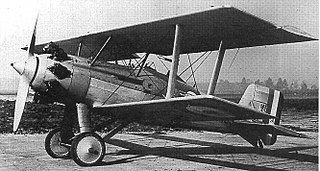
The Hawker Harrier was an experimental biplane torpedo bomber aircraft built by Hawker Aircraft to a specification issued in the 1920s for the RAF.

The Bristol Bulldog is a British Royal Air Force single-seat biplane fighter designed during the 1920s by the Bristol Aeroplane Company. More than 400 Bulldogs were produced for the RAF and overseas customers, and it was one of the most famous aircraft used by the RAF during the inter-war period.

The Hawker Woodcock was a British single-seat fighter built by the Hawker Engineering Company as the first fighter to be produced by Hawker Engineering. It was used by the RAF as a night fighter in the 1920s.

The Gloster Gauntlet was a single-seat biplane fighter designed and produced by the British aeroplane manufacturer Gloster Aircraft in the 1930s. It was the last fighter to be operated by the Royal Air Force (RAF) to have an open cockpit, and also the penultimate biplane fighter in its service.

The Hawker Hedgehog was a three-seat reconnaissance biplane, to be used for naval scouting, produced to meet Air Ministry Specification 37/22.

The Hawker Heron was the first fighter aircraft designed at Hawker Aircraft with a basically metal structure. Sydney Camm was the chief designer that introduced what became the typical structure for all Hawker aircraft until the introduction of the jet-powered Hawker P.1040. This structure consisted of metal tubes with their ends swaged so that they could be connected to each other by means of "fishplates" and bolts.

The Vickers Type 143 or Bolivian Scout was a British single-seat fighter biplane designed and built by Vickers in 1929-1930. Six were built for Bolivia in 1930, which used the survivors in the Chaco War against Paraguay.
The Hawker P.V.3 was a British single-engined biplane fighter prototype of the 1930s. Only a single example was built, the Gloster Gladiator being selected instead to fulfill the requirement to which it was designed.

The Gloster SS.35 Gnatsnapper was a British naval biplane fighter design of the late 1920s. Two prototypes were built but the type did not enter production.

The Bristol Boarhound was a British army cooperation and liaison aircraft of the 1920s. It was a two-seat biplane with wings of equal span, of steel frame construction with fabric covering.

The Bristol Bloodhound was a British two-seat reconnaissance/fighter aircraft designed and built by the Bristol Aeroplane Company as a possible replacement for the Bristol F.2 Fighter for the Royal Air Force. It was unsuccessful, only four prototypes being built.

The Westland Interceptor was a fighter developed by the British company Westland Aircraft to Air Ministry Specification F.20/27. When tested in 1929 and 1930, it showed unsatisfactory handling characteristics and was rejected by the RAF in favour of the Hawker Fury biplane fighter.

The Gloster Goring was a single-engined two-seat biplane designed to meet 1926 Air Ministry specifications for a day/torpedo bomber. It was not put into production and the one aircraft built served later as an engine testbed.

The Gloster Goldfinch was a single-engined single-seat high-altitude biplane fighter of all-metal construction from the later 1920s. It did not reach production and only one was built.

The Westland Weasel was a prototype British two-seat fighter/reconnaissance aircraft of the First World War. Designed to replace the Bristol Fighter, the Weasel was a single engined tractor biplane. Four prototypes were built, but no production followed owing to the failure of its original engine, although the prototypes were used as engine test beds for the successful Armstrong Siddeley Jaguar and Bristol Jupiter engines.

The de Havilland DH.77 was a prototype British fighter aircraft of the late 1920s. Intended as a fast climbing interceptor for Britain's Royal Air Force, the DH.77 was a lightweight low-wing monoplane powered by a relatively low power engine. Despite excellent performance, only one aircraft was built, the Hawker Fury biplane being preferred.
The Sopwith 2FR.2 Bulldog was a prototype British two-seat fighter of the First World War. A single-engined biplane, the Bulldog was a fighter/reconnaissance aircraft intended to replace the Bristol F.2 Fighter, but was unsuccessful, with no replacement for the Bristol Fighter being purchased.

The Hawker Hoopoe was a British prototype naval fighter aircraft designed and built in 1927 by Hawker Aircraft.

The Fairey Ferret was a 1930s British general-purpose biplane designed and built by the Fairey Aviation Company. It performed well in trials but was not ordered into production.

The Boulton & Paul P.33 Partridge was a single seat single-engined biplane fighter designed to an Air Ministry specification. One prototype was ordered and built for trials in 1928, but it was not put into production.


















